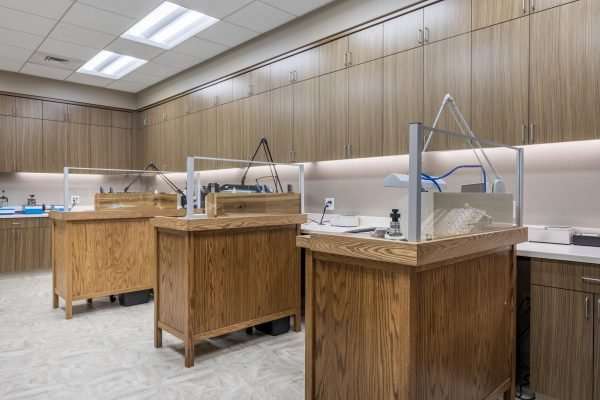FINE WATCH REPAIR
Pav & Broome Fine Jewelry began its watchmaking legacy more than 60 years ago and today features an onsite state-of-the-art watch repair facility. Our watchmakers have been trained and certified by many Swiss companies to expertly perform the servicing and repair of fine watches.
We are proud to be authorized Servicing Centers for Rolex as well as TAG Heuer, offering aftersales service for your luxury timepieces.
Visit Servicing Your Rolex at Pav & Broome for more information about servicing your Rolex watch. Click here for more information regarding TAG Heuer watch service and repair.
WATCH REPAIR
-
-
-
- Authorized Rolex Service Center
- TAG Heuer Certified Workshop Level 20A
- Watch Winding & Servicing
- Link Removal
- Clasp Repair and Replacement
- Battery Replacement and Installation
- Crystal Replacement
- Bracelet & Leather Strap Replacement
-
-
WATCH MAINTENANCE
While a watch can last for many years and even generations, like anything else, it does endure wear and tear over time. Pav & Broome’s watchmakers have provided their expert advice and professional tips to help you keep your watch in the same excellent condition in which it was bought.
GENERAL CLEANING
Keeping your watch clean on the outside lessens the chance of it getting dirty on the inside. Wipe off your watch periodically to remove dust, dirt, moisture, and perspiration.
Cleaning a NON-water-resistant watch:
- Avoid exposure to any moisture.
- Simply wipe the watch with a dry soft cloth.
Cleaning a water-resistant watch:
- Use a soft damp cloth to clean the head of the watch and then wipe it off with a dry soft cloth.
- Metal bracelets can be cleaned by using mild soapy water and a soft toothbrush.

MAINTENANCE SCHEDULE
In addition to an annual check-up, a complete movement overhaul, depending on the brand, some recommend every three to five years, while others recommend seven to ten years, is needed to keep your watch in pristine condition.
WINDING & SETTING
For a Manual Watch:
- Wind your watch fully at the same time each day.
- Be careful not to force the crown. When it stops, or you feel resistance, stop winding. Forcing the crown can damage the setting mechanism.
For an Automatic Watch:
For optimal performance, the automatic watch is to be worn every day and ‘be active.’
- To power up an automatic timepiece, give the crown about 20 to 40 turns and put the watch on your wrist.
- If the watch has a screw-down crown, be sure to secure it after the watch has been wound and set to ensure the watertight integrity of the watch.
- If the automatic watch is worn daily, wind it once every two weeks. Wind the watch twice a week if it is not worn daily.
For Setting the Date:
Avoid setting the date between 9 pm and 3 am as doing so can damage the movement’s gears and pinions. Be sure to adjust the date outside of this time period.
BATTERIES
The average life of a quartz watch battery is 1 to 3 years. The life of the battery is dependent on a number of factors: age, condition of the movement, and the type of watch—analog/chronograph or digital. The more functions a watch has, the more frequent the need for battery replacements. When a battery can no longer power the watch, change it promptly. Otherwise, you run the risk of the battery leaking and causing damage to the mechanism.
WATER RESISTANCE
Not all watches are designed to be water-resistant, and there are various degrees of water resistance. It is important to remember that water resistance is not a permanent condition, and it must be tested and renewed periodically. Gaskets and seals used to seal the watch deteriorate over time and will need to be replaced.
Have your watch tested every 12 − 18 months for water resistance. Bring your watch to Pav & Broome Fine Jewelry for repair if there is ever condensation under the crystal or signs of oxidation on the dial.
Swimming with your watch:
- If your watch is designed for water activities, be sure the crown is pushed down or screwed in tightly before wearing it in water.
- While in a moist environment, do not operate or adjust the crown and/or push buttons as water can seep into the case.
- After contact with chlorinated or salt water, immediately clean the watch with freshwater and dry with a soft cloth.
- If the watch has a ‘rotating bezel,’ be sure to rotate the bezel while cleaning to dislodge any debris (sand or salt).
THINGS TO AVOID
- Impacts
Sudden shocks or impacts to your watch may result in possible damage to the case, movement, crystal, dial, and hands, as well as void your warranty. When the unfortunate happens, the watch may no longer function as desired and will require service.
There are times when the impact is such that there is no physical evidence on the outside of the case indicating the watch has experienced a shock. Only a watch service center with trained expert watchmakers can diagnose the cause and advise you on a course of action to correct the problem.
- Extreme Temperatures
Moisture and drastic temperature changes and temperatures above 60°C/140°F and below 0°C/32°F can affect timekeeping and water resistance to most watches.
- Magnetic Fields
Mechanical watches exposed to anything containing a magnet can and will cause these watches to run incorrectly. The watch may run fast, slow, or even stop.
Avoid placing your watch on or near permanent magnets, as found in speakers, computers, magnetic hooks on refrigerators, etc. One of the most common culprits is the cell phone.
Bring your watch to a Pav & Broome service professional to have it quickly demagnetized. If the watch is severely magnetized, complete maintenance of the movement may be necessary.
- Chemicals
Direct contact with chemicals, such as cosmetics, perfumes, detergents, solvents, etc. may damage the case, gaskets, leather strap, and/or bracelet.
AUTOMATIC WATCHES:
Though many fine automatic watches are built to last more than a lifetime, they are subject to a variety of everyday stresses, from scratches and dents to magnetization or rust from water and perspiration. The most commonly reported issues with mechanical movements involve the movement, timing and/or dial.
Movement
Watch not running.
Dropping your watch or bumping against something abruptly may cause an axle of one or more wheels to break. Most commonly the balance staff breaks. When this happens the balance staff will need to be replaced and complete maintenance of the watch will be completed to make sure there are no other issues with the movement or timing of the watch.
An automatic, or self-winding, watch requires movement to wind fully. If you are not very active or are not wearing the watch on a consistent basis, the watch will not build up enough power to run. If you are wearing it and are active, it could be that the mainspring has become worn. This is rare but can happen. This is corrected by replacing the mainspring and conducting complete maintenance.
Timing
Watch running slow and/or stopping.
Automatic watches must be wound initially to start the watch, either by manually winding at the crown or by wearing the watch for enough time to wind the mainspring. When worn regularly, most automatic watches will function normally and continue to run for approximately 36 hours after being removed from the wrist. If the watch is fully wound and still runs slow, this is an indicator that it is due for maintenance. Most manufacturers of automatic watches recommend movement service approximately every 4 to 5 years, depending on the degree of wear/usage.
A watch is a finely tuned mini machine. Like an automobile’s engine, lubricants must be replaced periodically, usually every 4-5 years, to maintain optimum performance. Complete maintenance should correct this.
Watch running fast.
This is possibly caused by an issue with the hairspring. Over time, the internal lubricants in a watch movement may migrate to the hairspring and cause it to stick. It could also be from dropping the watch, in which case the hairspring is out of adjustment. Lastly, the watch may also have been exposed to a magnetic field and become magnetized.
When I wind my watch, it never stops winding.
This happens in true manual-wind watches and indicates that the mainspring has broken. Automatic watches’ mainspring has a bridle that allows the mainspring to slip in the barrel to keep the spring from being “over” wound. The mainspring must be replaced along with a complete maintenance.
DIAL
The crystal on my watch keeps fogging up, and I can’t see the dial.
The internal gaskets, which make a watch water-resistant, may require replacement or the watch may have been exposed to moisture while the crown was not properly closed. The crown, crystal and back gasket should be replaced in conjunction with a complete maintenance. The watch should be serviced as soon as possible, or other internal components might get damaged. It is important for wearers of water-resistant timepieces to be aware that water resistance is not a permanent feature and requires regular periodic service to be maintained.
The calendar changes at noon.
The hands are 12 hours out of alignment. Reset the watch manually by advancing the time by 12 hours.
The chronograph second hand does not set back to “0.”
This may be corrected by a simple manual re-setting of the chronograph hands. Over time, mechanical chronographs will require adjustment. When chronograph hands do not reset to zero, or 12 o’clock, it typically means the watch is due for its regular periodic maintenance.
QUARTZ WATCHES
Quartz watches, while not as delicate as mechanical movements, are not to be underestimated as they require their own servicing needs.
MOVEMENT
Watch has stopped running.
The first step is to see if the battery needs to be replaced. Most watch batteries are designed to last about 2 years. However, some quartz watches are designed to have extended battery life, which can last up to 3 or more years. (Most of these watches do not have second hands). A watch service technician will check the battery and the condition of the contacts.
The second hand ticks back and forth in one spot, and the watch does not run.
This may indicate the watch is functioning electronically, but the mechanical portion is not due to a problem with the internal gearing. Quartz watches have insufficient power to push through obstructions like mainspring-wound watches. In this case, the watch movement most likely needs to be serviced. Although there are numerous conditions that cause this malfunction, it is usually corrected by complete maintenance.
The watch runs fine until it is put on, then it stops.
This is somewhat of a common problem and could be because the electronic circuitry has a defect. One of the factors causing this to happen can be explained using the principles of basic physics. Expansion occurs when there is an increase in temperature. In this case, the electronic circuit may have a bad contact or defect within. When the watch is off the wrist at room temperature, all of the contact points and circuits function properly. However, when the watch is worn, body temperature causes a slight expansion and the circuit connection to break. This results in the watch no longer functioning. The circuit will need to be replaced in conjunction with routine maintenance.
The watch always stops at midnight.
The watch is most likely stopping due to a problem with the calendar trip mechanism. You should bring it in for service.
TIMING
The second hand skips several seconds at a time.
This is a battery end-of-life indicator (EOL). Watches with this feature have electronic circuits that detect when the battery voltage is getting low. Their circuitry makes the second hand move forward erratically to alert the wearer that it is time to replace the battery. Installing a new battery should restore the second hand to advance normally.
BATTERY
I use my chronograph often, and the battery life doesn’t last more than a year.
Using the chronograph function often or leaving it running constantly will considerably shorten battery life. It is important to understand that more battery power will be required to enable all of the numerous functions, more so than for basic timekeeping. It is not advisable to run the chronograph/stopwatch function continuously. In fact, some electronic chronograph/stopwatch functions will stop running automatically if left running for extended periods of time. To conserve battery power, it is best to stop the chronograph function when the timing feature is not being used.
I’ve had the watch for a year. Should I replace the battery just to be safe?
With many of today’s quartz watches having an end-of-life (EOL) feature, it is not advisable to replace the battery until it is absolutely necessary. Opening the case presents the possibility of compromising the factory seals, resulting in the need to perform water-resistant maintenance before it is required.
How long does a battery last?
This depends on the age of the watch and the type/ number of functions (i.e., stopwatch chronograph applications, alarms, second hand, etc.). A battery should last for at least 1 year in analog watches and digital styles.
The alarm worked fine until the battery was changed.
Several factors can cause this problem. The most common explanation is that the alarm contact spring is not in the correct position. The watch may need to be sent to the service center. Other possible causes may be the case back was installed incorrectly or there is a problem with the alarm contact plate. The watch will usually need to be sent for service.
DIGITAL DISPLAY
The display on my digital watch has turned black, and the numbers can no longer be seen.
This usually happens when a digital watch has received a severe shock or has been dropped. The digital display, a very thin sandwich of glass filled with a conductive fluid, has become either contaminated or cracked causing air to leak and damage the conductive fluid. This can be a very expensive repair and, depending on the value of the watch, replacing it may be the most economical alternative. Higher-end digital watches must be sent to the manufacturer’s service center.
The digits in my digital display do not show complete numbers or letters.
The contacts connecting the digital display with the circuitry of the watch have been damaged by a shock, or the contact points are corroded. This prevents the section(s) not displayed from receiving voltage necessary to ignite the display segment. In less expensive digital watches, the repair can cost as much as a replacement watch. If the customer wants the watch repaired, it will need to be sent to the manufacturer’s service center. Higher-end digital watches can be repaired at a reasonable cost compared to buying a new watch, but they must also be sent to the manufacturer’s service center.
The hands work but the digital display doesn’t or vice versa.
Analog/digital combination watches are really two watches built together. It is possible that one will malfunction leaving one part working. Watches with a digital feature must be repaired by the manufacturer’s service center.
PUSHBUTTONS
The pushbuttons don’t push in or will not return after being pushed in.
Push buttons have a stem attached to their underside that moves in and out of a tube located inside of the watch when depressed. Inside the watch, a tiny spring pushes the stem back out when the button is released. Over time, dirt or corrosion can accumulate inside the tube resulting in the spring being unable to restore the button back to its original position. The spring will most likely need to be replaced in conjunction with a complete maintenance.
Article of Hurricane Katrina damaged watch restored by Pav & Broome



